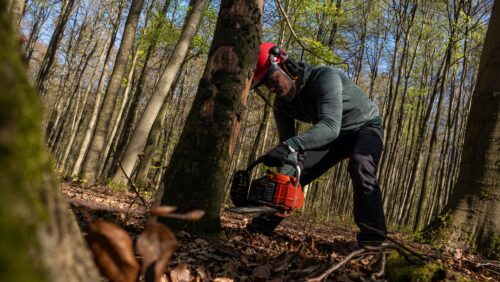Are you thinking of cutting down a tree on your property? Removing a tree isn’t something you can do on a whim! As experienced tree removalists and professional arborists, we know the ins and outs of cutting down trees. We explain whether you should remove your tree and how best to cut it down safely.
Should you remove your tree?
Before you decide to cut down your tree on your property, you first need to know whether you should remove it. Some trees are protected and there are restrictions about their removal as well as local council guidelines to be aware of. You also need to be careful if you are cutting a tree which is overhanging from a neighbour’s property as you could be liable for removing it. You may run the risk of removing a healthy tree or a tree which could be nursed back to health with careful pruning and care.
The main reason why people decide to remove a tree is because it is considered dangerous. You may also need to remove a tree if you’ve experienced a natural disaster like flooding or heavy rain, if it is too close to your home, or the roots are causing damage to your home. Sometimes, you may just find that is no longer viable, healthy or suiting the aesthetic of your garden. Whatever your reasons are for removing a tree, you need to ensure that you can remove it by having an arborist to inspect it.
How to cut down a tree on your property
Now that you’ve decided you should cut down your tree, we explain how to best remove it.
1. Receive an arborist report
To ensure that you can remove your tree, you should have an arborist report. A professional arborist will inspect your tree and make an assessment about whether it should be removed. Unlike an ordinary inspection, an arborist report is conducted by an experienced professional and can be used for any council permits, tree removal requests and other official processes.
As part of their report, an arborist will assess some of the following factors:
- The tree species and origin (whether it is native or not)
- The size (height and breadth) of the tree
- The overall health, age and structure of the tree
- The D.B.H (diameter at breast height)
- The T.P.Z (Tree Protection Zone)
- The S.R.Z (Structural Root Zone)
- The Arboricultural rating (the retention value)
- The S.U.L.E (safe useful life expectancy)
Following this report, an arborist may recommend the best course of action for your tree. This can include deciding that the tree and stump needs to be removed or the tree only requires pruning.
2. Decide whether to enlist the experts
Depending on what your arborist advises, you may need to enlist the help of a professional tree removal service to cut your tree down. Removing a tree is risky business, with multiple different dangers to factor in from personal injury to the damage of property. Choosing to remove your tree yourself exponentially increases these dangers. Hiring the professionals to handle the removal of your tree is the best way to ensure that your tree is removed properly without adding additional risk to yourself or surroundings. They are experienced and highly trained so can perform the steps of tree removal efficiently and with the right equipment.
3. Remove the stump
After cutting down the tree on your property, you’ll need to decide whether you also remove the stump. There are multiple advantages to removing the stump, including improving the appearance of your garden, removing a tripping hazard, and ensuring healthy growth of your existing trees by no longer diverting resources to a dying tree. You have a few different methods to remove your stump. You can choose to poison your tree stump which involves the application of toxic chemicals that slowly kill the stump over months. Or you can have your stump grinded, which uses heavy machinery to cut your stump into smaller pieces and even usable wood chips.
4. Clean up the green waste
Tree removal is only done once you’ve cleaned up the remaining green waste. You can decide to use the scraps of your removed tree and stump as mulch for your healthy trees and garden. Alternatively, you can dispose of your green waste in an appropriate skip or at landfill.

